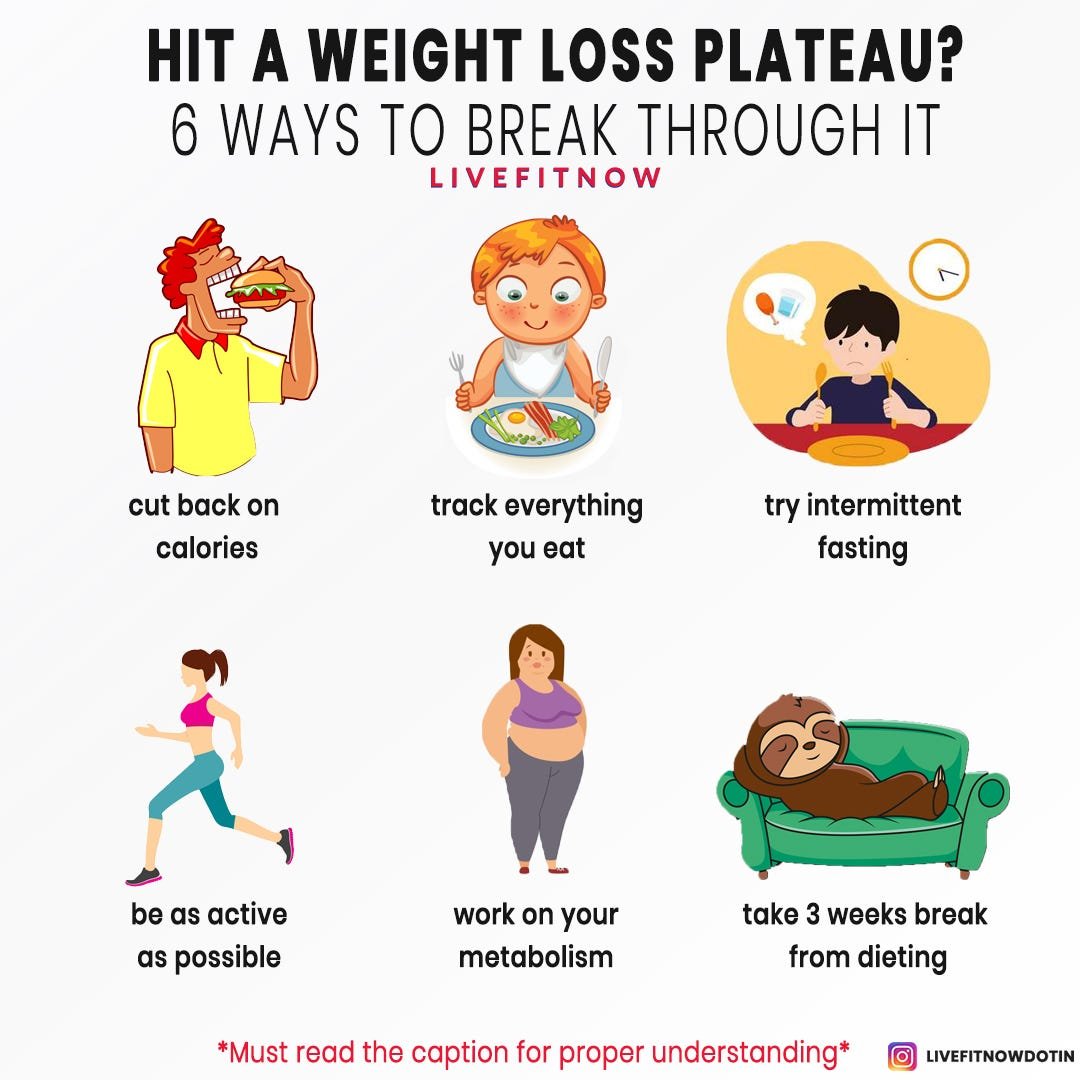Have you been working hard to lose weight but suddenly hit a wall where the scale just won’t budge? You’re not alone.
Weight loss plateaus can be frustrating, making you feel stuck and unsure about what to do next. But don’t worry—breaking through this barrier is possible, and you’re closer to success than you think. You’ll discover simple, effective strategies that can reignite your progress and help you reach your goals faster.
Ready to get moving again? Let’s dive in.

Causes Of A Weight Loss Plateau
Weight loss plateaus happen when your body stops losing weight. This can feel frustrating after steady progress.
Several factors cause plateaus. Knowing these helps you find ways to move past them.
Metabolic Adaptation
Your metabolism can slow down as you lose weight. This means you burn fewer calories than before.
This change helps your body conserve energy. It makes losing more weight harder over time.
Changes In Activity Level
You might move less without realizing it. Small changes in daily activity can reduce calories burned.
- Less walking or standing
- Reduced exercise intensity
- More sitting or resting
These changes lower your total energy use and can cause a plateau.
Dietary Habits
Eating habits may shift during weight loss. Portion sizes might increase without noticing.
Sometimes, small snacks or extra drinks add calories. These can stop weight loss progress.
- Unplanned snacks
- High-calorie drinks
- Less focus on meal quality
Muscle Mass Variations
Muscle is heavier than fat but burns more calories. Losing muscle can slow metabolism.
If you lose muscle during weight loss, your body uses fewer calories at rest. This can cause a plateau.
Adjusting Your Diet
Breaking through a weight loss plateau often means changing your diet. Small changes can help your body start losing weight again.
Focus on what you eat and how much you eat. Adjusting your diet can improve your results and keep you motivated.
Reassessing Calorie Intake
Your calorie needs may change as you lose weight. Eating the same amount might stop weight loss.
Check your calorie intake and compare it to your current activity level and weight. You might need to eat fewer calories.
- Track your daily calories for a week
- Calculate your new calorie needs
- Adjust portion sizes accordingly
Incorporating Nutrient-dense Foods
Nutrient-dense foods give your body vitamins and minerals without many calories. They help you feel full longer.
Choose vegetables, fruits, whole grains, and lean proteins. These foods support your health and weight loss goals.
- Leafy greens like spinach and kale
- Berries and citrus fruits
- Whole grains such as brown rice and oats
- Lean proteins like chicken and beans
Timing Your Meals
When you eat can affect your metabolism and hunger. Spreading meals evenly can help control cravings.
Try eating smaller meals every three to four hours. Avoid skipping meals to keep energy steady and reduce overeating.
- Eat breakfast within one hour of waking
- Include protein in every meal
- Have healthy snacks if you get hungry
- Finish eating at least two hours before bed
Reducing Processed Foods
Processed foods often have added sugars, salt, and unhealthy fats. These can slow weight loss and harm health.
Cutting back on processed foods helps you eat cleaner and feel better. Choose fresh, whole foods as much as possible.
- Avoid sugary drinks and snacks
- Limit fast food and ready-made meals
- Read labels to spot added sugars and fats
- Cook meals at home with simple ingredients
Enhancing Physical Activity
Breaking through a weight loss plateau can be tough. One way to move forward is by improving your physical activity.
Changing how you exercise helps your body burn more calories and build muscle. This can restart weight loss progress.
Increasing Workout Intensity
Try to work out harder by adding more effort. This means pushing yourself a little more during exercise.
You can increase intensity by running faster, cycling harder, or lifting weights with more effort.
- Shorten rest times between sets
- Add more repetitions or sets
- Pick exercises that challenge your heart rate
Adding Strength Training
Strength training builds muscles that burn calories even when you rest. This helps you lose weight faster.
Use weights, resistance bands, or bodyweight exercises like push-ups and squats to add strength training.
- Lift weights two to three times a week
- Focus on all major muscle groups
- Increase weight gradually to build strength
Including High-intensity Interval Training
High-Intensity Interval Training (HIIT) mixes short bursts of hard exercise with rest periods. It burns many calories fast.
HIIT can improve fitness and help break weight loss plateaus by challenging your body in new ways.
- Try 20 to 30 seconds of fast effort
- Follow with 30 to 60 seconds of rest
- Repeat for 10 to 20 minutes total
Varying Exercise Routines
Doing the same exercises can cause your body to adapt. Changing your routine keeps your body guessing.
Try new activities, change the order of exercises, or switch workout types to avoid plateaus.
- Swap running for swimming or cycling
- Try yoga or Pilates for flexibility
- Use different equipment like kettlebells or medicine balls
Lifestyle Modifications
Breaking through a weight loss plateau can be tough. Small changes in your daily habits can help restart progress.
Focus on improving your lifestyle to support your weight loss efforts. These changes make a big difference over time.
Improving Sleep Quality
Good sleep helps your body burn fat better. Lack of sleep slows your metabolism and increases hunger.
Try to get 7 to 9 hours of sleep each night. Create a calm and dark room for better rest.
- Go to bed at the same time daily
- Avoid screens before bedtime
- Limit caffeine late in the day
- Use relaxing routines like reading or meditation
Managing Stress Levels
Stress causes your body to hold onto fat. It can also lead to emotional eating and poor choices.
Find ways to reduce stress in your life. This helps your weight loss stay on track.
- Try deep breathing exercises
- Practice yoga or gentle stretching
- Spend time outdoors or in nature
- Talk to friends or family for support
Staying Hydrated
Drinking water helps your body work well. It can also reduce hunger and prevent overeating.
Drink water before meals to feel fuller. Aim for about 8 cups of water daily.
- Carry a water bottle with you
- Replace sugary drinks with water
- Eat water-rich fruits and vegetables
Tracking Progress Accurately
Track your weight loss with care. Use the same scale and time to measure yourself.
Also track other signs like how your clothes fit or your energy levels. This gives a full picture.
- Weigh yourself once a week
- Take body measurements regularly
- Note your physical endurance and strength
- Keep a food and exercise journal
Using Supplements Wisely
Hitting a weight loss plateau can be frustrating. Some people try supplements to help break through it.
Using supplements wisely means understanding their effects and limits. Not all supplements work the same for everyone.
Evaluating Popular Supplements
Some supplements claim to boost metabolism or reduce appetite. Common ones include green tea extract, caffeine, and protein powders.
Check if scientific studies support the supplement’s claims. Look for products with clear ingredient lists and no harmful additives.
- Green tea extract may increase calorie burn slightly
- Caffeine can boost energy and focus during workouts
- Protein powders help build muscle and reduce hunger
- Fiber supplements may improve fullness and digestion
Consulting Healthcare Professionals
Talk to a doctor or dietitian before starting supplements. They can check for risks based on your health and medications.
Professionals help you pick safe options and avoid side effects. They also guide how to use supplements with your diet and exercise plan.
- Discuss your current health conditions
- Share all medications and supplements you take
- Ask about the right dosage and timing
- Get advice on brands and quality
Avoiding Over-reliance
Supplements do not replace healthy eating and exercise. Relying too much on them can slow your progress.
Use supplements as a small part of your overall plan. Focus on balanced meals, regular workouts, and good sleep first.
- Do not expect quick fixes from supplements
- Watch for side effects or unusual symptoms
- Stop using supplements if they cause problems
- Keep your main focus on lifestyle changes
Seeking Professional Support
Hitting a weight loss plateau can be frustrating. Getting help from professionals can guide you past it.
Experts offer advice tailored to your needs. They help adjust your plan for better results.
Working With Nutritionists
Nutritionists study food and how it affects your body. They can create meal plans that fit your goals.
A nutritionist can find hidden diet issues. They help balance nutrients and control portions to restart weight loss.
Hiring Personal Trainers
Personal trainers design exercise routines that fit your fitness level. They keep workouts fresh and challenging.
Trainers correct your form to prevent injuries. They motivate you to stay consistent and push harder.
- Set new fitness goals
- Track progress regularly
- Introduce varied exercises
Joining Support Groups
Support groups connect you with others on similar journeys. Sharing challenges helps you stay motivated.
Group members exchange tips and celebrate successes. This social support can boost your confidence and commitment.
- Meet weekly or online
- Share experiences and advice
- Receive encouragement during tough times

Frequently Asked Questions
How Long Does A Weight Loss Plateau Usually Last?
A weight loss plateau typically lasts two to six weeks. It occurs when your body adjusts to your current routine. Breaking the plateau requires changing your diet or exercise plan to boost metabolism and continue losing weight effectively.
What Exercises Help Break A Weight Loss Plateau?
High-intensity interval training (HIIT) and strength training can break plateaus. These exercises increase muscle mass and calorie burn. Mixing cardio with resistance workouts challenges your body, preventing adaptation and reigniting weight loss progress.
Can Changing Diet Break A Weight Loss Plateau?
Yes, adjusting your diet can break a plateau. Try reducing calorie intake slightly or increasing protein. Avoid processed foods and focus on whole, nutrient-dense meals. Small changes help reset your metabolism and support ongoing weight loss.
Should I Increase Workout Intensity During A Plateau?
Increasing workout intensity can help overcome a plateau. Push yourself with heavier weights or longer sessions. This challenges your body and boosts calorie burn, helping to restart weight loss when progress stalls.
Conclusion
Breaking a weight loss plateau requires patience and small changes. Try varying your diet and exercise routine. Track your progress to see what works best. Staying hydrated and getting enough sleep can help too. Remember, consistency is key. Celebrate small victories along the way.
Don’t be discouraged if progress seems slow. Every step counts. Stay motivated, and keep your goals in mind. You’re closer to success than you think. Keep pushing forward, and you’ll overcome the plateau. Stay positive, and believe in your ability to change.
Your journey is worth it.



